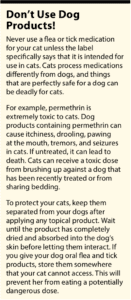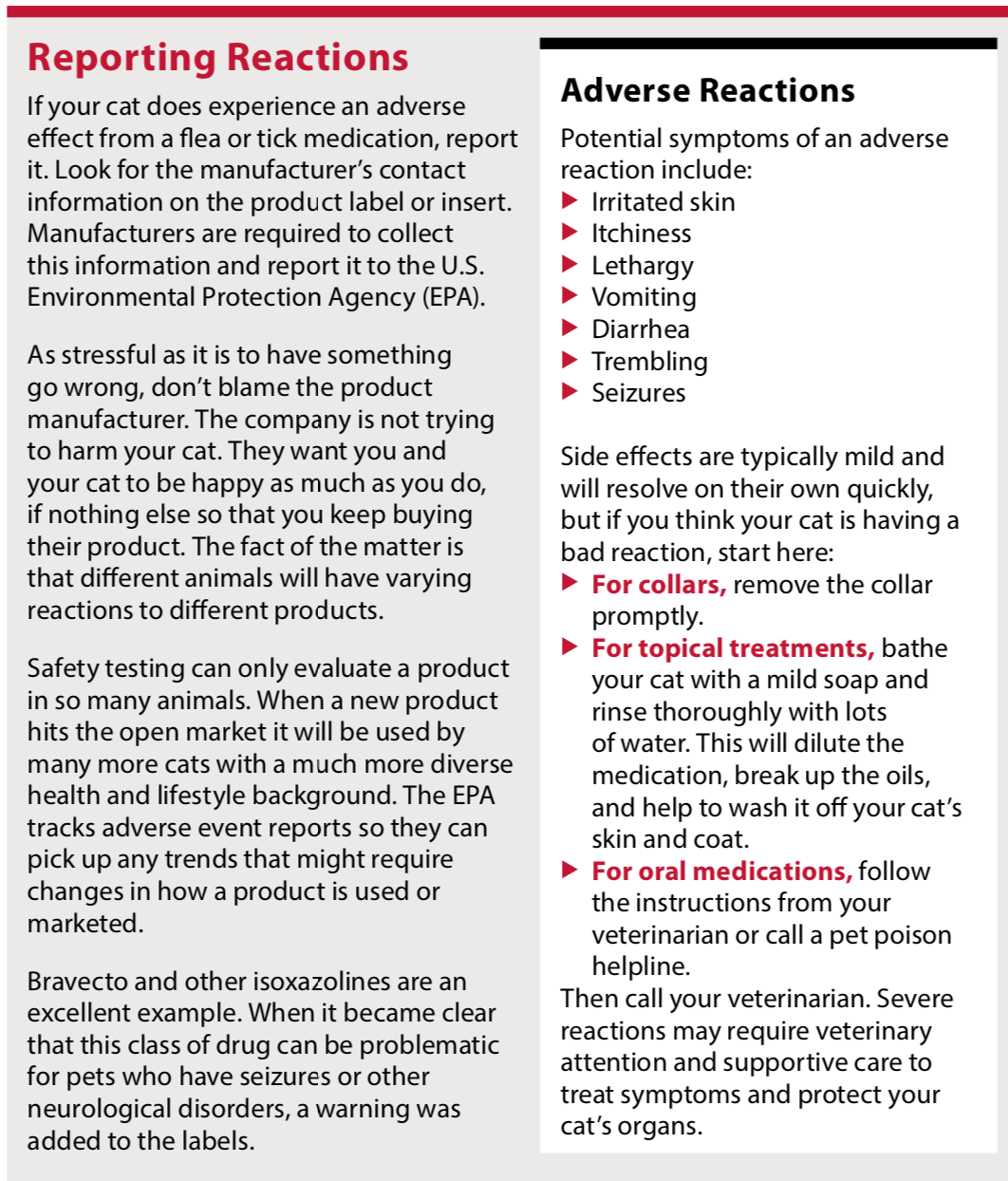As cat lovers with budgets and sometimes multiple felines in our household, most of us try to provide the best care we can at a reasonable cost. This means giving them everything they need and avoiding things that they don’t need. But flea and tick medications are a bit of a gray area for cats (see sidebar).
Some people try to save money by increasing the time beween doses of these preventatives, but if you do that, you’re actually wasting your money because you’re risking an infestation. The redosing periods are based on research to optimize effectiveness.
Monthly Means Monthly
Every product will tell you how long it is effective. Many topical products are good for 28 to 30 days, and Bravecto is good for 12 weeks. Oral products that are safe for cats range from the short-acting Capstar to monthly durations of efficacy. The collar Seresto is good for eight months, but it may only be effective against some tick species for a shorter length of time, especially if your cat swims or is bathed frequently.
It can be tempting to stretch the intervals between doses. This is a dangerous game, especially if you are already dealing with an infestation.
When you give or apply a flea/tick medication late, the previous dose will “run out” and become less effective. That gap could be enough time to allow an infestation to take hold, especially if the product you are using only targets one stage of the flea life cycle.
For example, the topical product Cheristin is labeled to apply monthly to prevent fleas in cats. This product can be effective up to six weeks and kills adult fleas. If you forget to reapply until eight weeks after the first dose (two weeks beyond the maximum reported efficacy and a month past the recommended dosage frequency), any eggs and pupae that hatch into adult fleas in your house will cheerfully start snacking on your poor cat. These adults—or any new adults brought in from outside—will also reproduce and lay more eggs, perpetuating the cycle.
Remember that flea eggs and pupae can live around your house, not just on your cat. They are also much more hardy than adult fleas. Pupae can remain dormant for months until conditions are favorable for them to hatch. Just because you can’t see any adult fleas does not mean that your house is clear.
Know How the Product Works
The first thing to check before using any flea and/or tick medication is the size and age requirements. Most cat-safe products are appropriate for most adult cats, but some do have different dosages for larger and smaller cats. Kittens are smaller and more sensitive, so it is critical to make sure the product you are using is safe for your kitten’s age and weight.
Different products have different methods of action. Some products kill parasites on contact, while others require the parasite to bite your cat before they can work. Some products target adult fleas, while others contain growth inhibitors that target flea pupae to prevent them from hatching into adults. Products may repel fleas, preventing them from getting onto your cat in the first place (this is rare for ticks).
In addition to understanding how the product kills unwanted guests, you will need to know how long it works. For example, Capstar is great at killing adult fleas quickly, but only continues to work for a matter of hours. The product label recommends repeating once a day if you continue to see fleas. This quickly becomes impractical, so often a better solution is to start with a dose of Capstar and follow with a longer-acting option.
Read product labels or consult with your veterinarian to find out how the product kills or repels parasites and which parasites it is effective against. For example, the oral product Comfortis works great against fleas but will not help with ticks.
Treating All Pets
 One of the biggest challenges to eradicating a flea or tick infestation is having multiple pets. Every single dog and cat in your house can be a host. If you find fleas or ticks on one pet, all of them must be treated. Otherwise, the fleas will just focus on the untreated pet(s).
One of the biggest challenges to eradicating a flea or tick infestation is having multiple pets. Every single dog and cat in your house can be a host. If you find fleas or ticks on one pet, all of them must be treated. Otherwise, the fleas will just focus on the untreated pet(s).
Most veterinarians recommend treating all pets for at least three consecutive months to clear an infestation. This plan gives enough time to catch fleas at multiple points in their lifecycle, whereas if you only treat for one month, some pupae may outlast the medication. Treating all of the pets prevents any of them from bringing in more parasites or acting as a safe harbor for the existing issue.
Flea Allergies
If your cat is one of the unlucky felines with a flea allergy, even one flea bite can cause her skin to erupt in itchy, scaly unpleasantness. It is critical to keep cats with flea allergy dermatitis on a year-round preventative to protect them from allergy symptoms.

It is strongly recommended to keep up treatments for all pets in the household. If your indoor cat has a flea allergy, a cat who goes outside or your dog can easily bring home more fleas. Remember that it only takes one bite to trigger an allergy—even if the flea dies immediately after biting your cat, your cat is still going to be uncomfortable.
Regional Differences
Unfortunately, not all products work the same in all areas. Some ticks are more resistant to many drugs than others. The Lone Star tick and Asian longhorned tick are notorious for being tougher than other tick species.
Veterinarians are also noting regional drug resistance in fleas and ticks. Ask your veterinarian which product(s) are still effective in your area before purchasing.ν
Evaluating Risk
Flea and tick medications fall into a gray area for many cat owners, especially if your cat stays indoors. The Companion Animal Parasite Council recommends year-round flea and tick prevention for all cats to prevent parasite infestations in your home and to protect both you and your pets from vector-borne diseases.
Ticks are primarily an outdoor parasite, and your area likely has at least one tick species no matter where you are. Cats who go outdoors are at risk of contracting tick-borne diseases. Cats who stay indoors are unlikely to encounter most tick species, except for the brown dog tick, which will live indoors.
Fleas are another story. Fleas thrive in indoor environments and can be easily passed from animal to animal. Adult fleas may not survive a cold winter outdoors, but their eggs can survive for five months or more. Flea eggs and pupae can also live in bedding or in the floors and furniture in your house.
Fleas can ride in on your clothing and other pets. If even one pet goes outside or interacts with other animals, every pet in the house can potentially be exposed to fleas.
Depending on where you live and your pets’ lifestyle, you may be able to use a flea and tick medication part of the year. Just keep in mind that it only takes one warm day for critters to thaw out and become active again even in the winter. Discuss what your cat’s parasite exposure risk is with your veterinarian, and be honest about where your pets go. And be prepared that the best answer might be year-round preventive medications.




